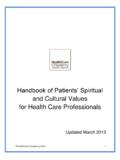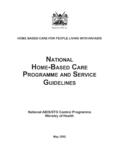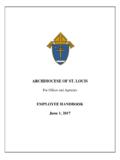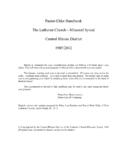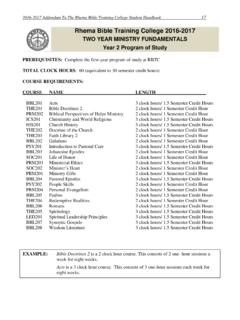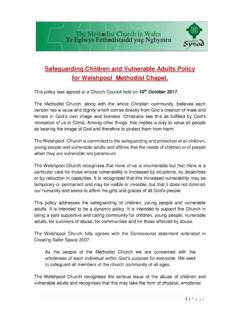Transcription of The Handbook on Licensed Lay Ministry
1 The Handbook on Licensed Lay Ministry The Episcopal Diocese of Fort Worth Commission on Ministry : Committee for Lay Ministry September 2001. INDEX. 3. Lector ..Page 5. Lay Reader ..Page 6. Lay Eucharistic 7. Lay Eucharistic Visitor ..Page 9. 11. Lay Chaplain ..Page 12. Forms for Licensing ..Page 16ff The Episcopal Diocese of Fort Worth Center for Ministry 2900 Alemeda Street Fort Worth, TX 76116. PREFACE. The purpose of The Handbook on Licensed Lay Ministry is to provide a resource for clergy and congregations on calling, training, and setting apart lay ministers to serve in the worship of the Church. The Book of Common Prayer defines four orders of ministers in the Church: lay persons, bishops, priests, and deacons. Baptism into the Covenant Community of Jesus Christ is the primary prerequisite for any Ministry in the Church. Ministry in the Church has usually involved some prior training, an examination of life and ability, and a setting apart, or an expression of approval, of the person by the people, the clergy, and the bishop.
2 Lay ministers are called in the Book of Common Prayer to take their place in the life, worship, and governance of the Church (p. 855). This Handbook will assist congregations with the training and licensing of lay ministers who are called to serve through the worship of the Church. Six specific liturgical ministries can be found in this Handbook . These include: Lector Lay Reader Lay Eucharistic Minister Lay Eucharistic Visitor Catechist Lay Chaplain 3. Each section of the Handbook will include a description of the function of the Ministry , a means of calling for the Ministry , standards of training and examination for the Ministry , licensing requirements, and special notes. Forms for licensing of lay ministers, for duplication, are provided at the back of this Handbook . References for this Handbook come from: The Book of Common Prayer, 1979. The Book of Occasional Services, 1997. The Customary of the Episcopal Diocese of Fort Worth, 1996.
3 The Constitution and Canons of the Episcopal Church, 1997. Additional information on the Licensed lay ministries can be obtained through the Diocese of Fort Worth or the Commission on Ministry : Committee on Lay Ministry . In all service, the entire Christian assembly participates in such a way that the members of each order within the Church, lay persons, bishops, priests, and deacons, fulfill the functions proper to their respective orders, as set forth in the rubrical directions for each service (BCP, p. 13). 4. LECTORS. FUNCTION. The function of Lectors, is to read the Lessons in the Church's liturgy as appointed to do so by the celebrant or officiant. It would appear that only in exceptional cases should the lessons be read by a deacon or priest. Book of Common Prayer rubrical directions concerning Lectors include the following: p. 284 Lay Persons read the Lessons and the Epistle . The Great Vigil of Easter p. 312 Lay Persons may act as readers, and it is appropriate for sponsors to be assigned this function.
4 Holy Baptism p. 322 Lay Persons appointed by the celebrant should normally be assigned the readings of the Lessons which precede the Gospel, and may lead the Prayers of the People . The Holy Eucharist For Holy Eucharist, Celebration and Blessing of a Marriage, Ministration to the Sick, the Burial of the Dead, Ordination services of Bishops, Priests, and Deacons, Celebration of a New Ministry , and Consecration of a Church see pp. 406, 422, 453, 468, 490, 512, 528, 540, 558, and 571. QUALIFICATIONS FOR LECTORS. 1. Baptism 2. Appointment to that function by the celebrant of officiant 3. Ability to read clearly, audibly, and with the sense of the passage NOTES. - Lectors usually do not vest and may come up from the congregation to the lectern to read (unless parish custom dictates otherwise). - Congregations may wish to give certificates to Lectors in recognition of their commitment to service in the public worship of the Church. 5. LAY READER.
5 FUNCTION. Lay Readers function in the same role as a lector with the exception that they are Licensed by the Bishop to lead public worship under the direction of a Member of the Clergy in charge of the Congregation. (Title III, Canon ). QUALIFICATIONS FOR LAY READERS. 1. Baptized member in good standing in the congregation in which they intend to serve. 2. Completed all training and passed examination. 3. Demonstrates ability to lead public worship. 4. Licensed by the Bishop upon completion of training. MEANS OF CALLING. 1. In some cases, persons will indicate to the clergy the desire or sense of calling. 2. In other cases, clergy and leaders will seek out and recruit readers. 3. In certain rites, particularly Baptism and marriage, persons in a special relationship to those for whom the rite is being celebrated may be designated by the celebrant to read. TRAINING. 1. How to announce and conclude the Readings. 2. How to use the Lectionary.
6 Rules concerning the lengthening and shortening of appointed Psalms and Lessons How to use the Calendar of the Church year. (BCP, p. 15ff). How to look up pronunciation of biblical words and names. Know the authorized translations of the Bible. Parish customs concerning the reading of Scripture and those who read it. Use of voice. How to modify opening phrases of Lessons as in the next to the last paragraph on p. 888 of BCP. Demonstrate an ability to lead Daily Offices with appropriate readings and prayers. Customs of the congregation for public worship. EXAMINATION. 1. An oral reading of two or more passages of Scripture. 2. Successfully officiate at Morning and Evening Prayer. 0. Demonstration of ability to use the Lectionary. 6. 1. List the Psalm(s) and Readings for Daily Morning prayer for Tuesday, Proper 10, in the current year. 2. List the Psalm and Readings for Daily Evening prayer for the Feast Day of St. Stephen. 3. List the Old Testament and Epistle Readings for the 2nd Sunday after the Epiphany in the Current Year.
7 4. List the Old Testament and Epistle Readings for Proper 14, Year B. LICENSING. The license is granted only by the Bishop at the recommendation of the Rector or Vicar of the congregation in which the applicant will serve. The license will be issued for a period not to exceed three years and can be revoked by the Bishop upon request of the Rector or Vicar in charge of the congregation. Forms for licensing and for the renewal of a license are available in this Handbook . NOTES. Lay Readers may read sermons authorized by the Bishop or the Rector or the Vicar in charge of the congregation. LAY EUCHARISTIC MINISTERS. FUNCTION. A person Licensed to administer the chalice is best described as an extraordinary minister of the Sacrament . That is, such a Ministry is permitted only when there are not enough ordained ministers for the efficient administration of the Sacrament. It is certainly not proper, as directed by the BCP, nor in accordance with the spirit of the Canons, that a Lay Eucharistic Minister exercise that Ministry when there are adequate numbers of clergy present (see Title III, Canon 3, sec.)
8 5a). To support the intentions of the rubrics of the BCP and the Canons of the Church, the Bishop of the Diocese of Fort Worth has restricted this Ministry to the congregation in which they are Licensed . Lay Eucharistic Ministers are not authorized to carry the Sacrament to the sick (please see Lay Eucharistic Visitor). Lay Eucharistic Ministers may function during the administration of Holy Communion, when needed, in administering the chalice. They may, if the Celebrant desire, assist the Deacon in oblations, or if there is no deacon, the Lay Eucharistic Minister may do oblations. 7. QUALIFICATIONS. 1. Baptized member in good standing of the congregation in which they intend to serve. 2. Completed training and passed examination. 3. Licensed by the Bishop upon completion of examination. MEANS OF CALLING. It will be the Rector or Vicar who chooses those to be trained and Licensed by the Bishop for this Ministry . TRAINING. Lay Eucharistic Ministers will be trained in the following: 1.
9 How to administer the Chalice. 2. What to do when the Chalice is depleted. 3. Diocesan policy regarding intinction. 4. The status of Eucharistic Minister as extraordinary, not normative. 5. The Anglican Doctrine of the Real Presence. EXAMINATION. Examination by the Rector or Vicar: 1. Performance of administration from the chalice and oblations in the service of Holy Communion. 2. Oral explanation of the following: Anglican doctrine of the Real Presence . Reservation of the Sacrament. Intinction, and the Diocesan policy regarding the same. Procedure to be used by Lay Eucharistic Ministers when contents of chalice have been depleted. LICENSING TERM OF SERVICE. The license is granted only by the Bishop at the recommendation of the rector or 8. vicar of the congregation in which the applicant will serve. (See Customary, p. 11). The license shall be issued for a period of time not to exceed three years and can be revoked by the Bishop or upon request of the rector or vicar in charge of the congregation.
10 Forms for the renewal of a license are available in the back of this Handbook . The license may be presented in a service of public worship before the congregation in which the Lay Eucharistic Minister in the Church (see ). NOTES. - Lay Eucharistic Ministers should vest in cassock and surplice when serving the chalice. - In certain cases, Lay Eucharistic Ministers may read sermons authorized by the Bishop or the Rector/Vicar in charge of the congregation. - Candidates for Holy Orders in a theological education are automatically granted a Lay Eucharistic Ministers license in the congregation where they serve. LAY EUCHARISTIC VISITOR. (Visitor of the Sick and Shut-in). FUNCTION. A person Licensed to carry the Sacrament to the sick and shut-in is best described as an extraordinary minister of the Sacrament . To support the intentions of the rubrics of the BCP and the Canons of the Church, the Bishop of the Diocese of Fort Worth has restricted this Ministry to the congregation in which they are Licensed .

